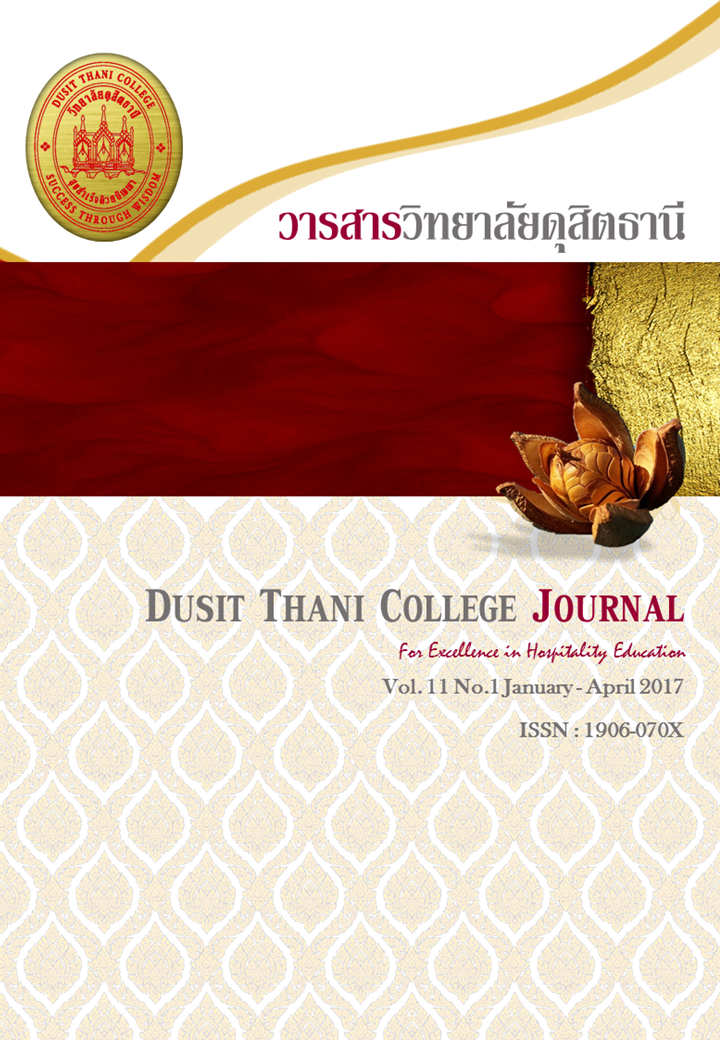Potential Factors of Eco-Tourism in Samutsakhon
Main Article Content
Abstract
The study of “Potential Factors of Eco-tourism in Samutsakhon” aims to 1) to explore and survey eco-tourism in Samutsakhon and 2) to study the potential factors of ecotourism in Samutsakhon. This study was quantitative research. The research tool was the quantitative questionnaire which collected from 4 group samplings such as 400 Thai tourists sampling groups, 14 government staffs, 10 stakeholders, and 6 persons of the private community. The questionnaire data analysis was based on the Descriptive Statistics (Frequency, Percentage, Mean, and Standard Deviation). The hypothesis testing was done on the Inferential Statistics (Chi-square, T-test, ANOVA or F-test, Scheffé's method, and Multiple Regression Analysis) by using the determination of statistical significance at 0.05 level.
The results found that 1) The most tourists who travel in Eco-tourism attractions are female 58.50 percentages and male 41.50 percentages. The total average of potential factors was high level which they were the environment, the value of tourism, the physical background of the area, the convenience access, the tourism facilities, and the good reputation. 2) The tourists had opinion in the eco-tourism activities and the satisfaction of eco-tourism in high level 3) The Potential factors of Eco-tourism in Samutsakhon for government, staff, stakeholders, and private community are female 56.70 percentages and male 43.30 percentages. The total average of potential factors was middle level which they were the environment, the value of tourism, the management, the convenience access, the tourism facilities, the good reputation, the community participation, and the limitations of tourism sector.
The results of Hypothesis Testing found that 1) The different of age, occupation, and regular income of tourists effected withthe potential factors in 0.05 significance level 2) The potential factors which are the convenience access, the environment, and the physical background of the area effected with the eco-tourism activities 3) The potential factors which are the value of tourism, the convenience access, the environment, the good reputation, and the physical background of the area effected with the satisfaction eco-tourism.
Article Details
Article Screening Policy
- All research and academic articles to be published must be considered and screened by three peer reviews in the relevant field / article.
- All articles, texts, illustrations and tables published in the journal are the personal opinions of the authors. Editors don't always have to agree. And no responsibility whatsoever is the sole responsibility of the author.
- The articles to be published must never be published. Where did you first publish? And not in the consideration of other journals If the audit found that there has been a duplicate publication It is the sole responsibility of the author.
- Any article that the reader sees as being plagiarized or impersonated without reference. Or mislead the work of the author Please let the journal editor know it will be your greatest blessing.
References
Chatdanai Jaisa-ngiam. (2012). Potential of Sustainably Community Tourism: Koh Kerd Community, Ayutthaya Province. Thesis. Master of Arts. Naresuan University.
Chusit Chuchart. (2011). Tourism Industry. Chiang-mai: Lanna Printing.
Department of Tourism, Ministry of Tourism and Sports. (2015). The Summary of Tourism Situation for Domestic in 2015. Available from: https://www.m-society.go.th/article_attach/14254/17999.pdf. Cited 25 October 2015.
Division of Conservation, Tourism Authority of Thailand. (2002). The workshop document of Eco-tourism for the project of Eco-tourism promotion and development in 2002. Independent Study. Master of Arts. Pitsanulok University.
Duangkamol Buntaweesub. (2012). The factors effected with the satisfaction of Thai tourists who traveled to Pu Toey National Park, Supanburi province. Thesis, Master of Arts. Dhurakij Pundit University.
Krit Kotsombat. (2010). The Evaluation of Potential of Eco-tourism: attraction in Kang Sam Pan Bok, Sam Pan Bok District, Ubonrachatani Province. Ubon Ratchathani Rajabhat University.
Parichat Singhasaktrakul et al. (2010). “The Study of Potentiality and Conservation Tourism Development Approach of Baan Thung-Maprang, Kuan Doan District and Baan Ton-Panan, Kuan Kalong District in Satun Province”. Suthiparithat Journal. 27(83), 97-112.
Prahaschai Ramad. (2014). “Potential of ecotourism development guideline of Thai tourists in the Khaoyai National Park”.Journal of Technical Education Development. 26(90), 30-36.
Vipa Srirathu. (2008). Eco-Tourism Potential of Amphoe Khao Kho, Phetchabun Province. Master Project, Master of Science Degree (Ecotourism Planning and Management). Srinakarinwirot University.
Wiwatchai Boonyapak. (1986). “The Impact of Tourism Industry in Art and Cultural Heritage”. TAT Review Magazine. 4, 31-38.
Yuwadee Chukerd. (2010). Ecotourism Development Strategy of Borhin Sub-District, Sikao District, Trang Province. Thesis. Master of Public Administration. Khon Kaen University.


